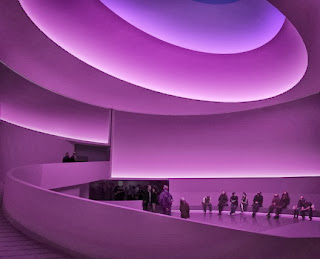Light is not just used for 'making visible the architectural structure', it is also used for giving new experiences and perception, effecting pyschology.
Light could be classified as natural light and artificial light. Natural light is commonly used for sembolic images or mystic environments. After the 19th century, artificial light is started to added to buildings, this situation developed the night life and added more dynamics to cities.
Natural Light
the Church of Light, Tadao Ando

The Church of the Light embraces Ando’s philosophical framework between nature and architecture through the way in which light can define and create new spatial perceptions equally, if not more so, as that of his concrete structures.
the Chapel of Notre Dame du Haut, Le Corbusier


Ronchamp sits among a wooded terrain secluded from the rest of the commune; the chapel is placed atop a hill on the site setting itself on a metaphorical pedestal giving Ronchamp added importance. Unlike most of Corbusier’s other works consisting of boxy, functional, and sterile volumes, Ronchamp is more of an irregular sculptural form where the walls, the roof, and the floor slope. Stylistically and formally it is fairly complex; however, programmatically it is relatively simple: two entrances, an altar, and three chapels.
There is a lot of architects such as Ricardo Legoretta, Peter Zumpthor, Steven Holl who knows the nature of light as a design element. To control the built environment and to create the requirred dynamics in a space, it is necessary to know properties of light which is an essential component of the design and to create spatial organization. The importance of light is related to communicate mutually with the elements of space such as structure, form, volume and the upper plane as time or limit. Space can assume a different character with the help of light and the designer's relation with light.
Artificial Light
the invention of the electricity at the 19th century is caused to new relationship between space and light. That rising lighting techology gives rise to new notions like light art and mediarchitecture.
The tower is constantly transforming, its small lamps changing colors according the surrounding sounds and
its neon rings rippling according to the winds of the city. As a result there is no pattern since the display of light is a direct representation of the environment, portrayed on a 21 meter high cylindrical surface. The project sits as a technological sculpture, welcoming travelers arriving at the rail way station of Yokohama, and oddly enough housing water tanks serving air conditioning machinery for an underground mall that it sits atop. Toyo Ito creates an infinite relationship between technology, architecture, the city, and its inhabitants emphasizing the profound impact of the city on the human race and the crucial role of technology in architecture.
Guggenheim Museum, James Turrell
Daylight and LED light. Site-specific installation
Roden Crater, East Portal The Light Inside, The Museum of Fine Arts
Neon and ambient light
Since 1972 American artist James Turrell has been transforming the “Roden Crater” into a monumental work of art. Located under the blue sky of northern Arizona, the natural volcano is converted into a revelation of celestial phenomena: the sun, moon and stars. For Turrell, the “Roden Crater” is dedicated to the sky: “I am not an “earthwork” artist. I am totally involved in the sky. Let me make this very clear: the main thing is that I am totally interested in space and not in form.”
To heighten the light experience of a uniform blue sky, Turrell erases the gradation near the horizon; as he states: “…if you go to the Rocky Mountains, to a high altitude where it is cold, you see sky that is such a crisp blue you feel that you could cut it and put it in cubes! That is the kind of sky I want, and I have been able to get it by selecting the altitude. There are gradations near the horizon where the blue is lighter, and then gradually, toward the zenith, it gets deep. With Roden Crater I have taken out the first fifteen degrees of height by aiming the tunnel sight lines above that level. At that point you see thirty degrees less than one hundred eighty degrees. That is how you get that incredible color – by eliminating all of the white at the horizon.”








Hiç yorum yok:
Yorum Gönder